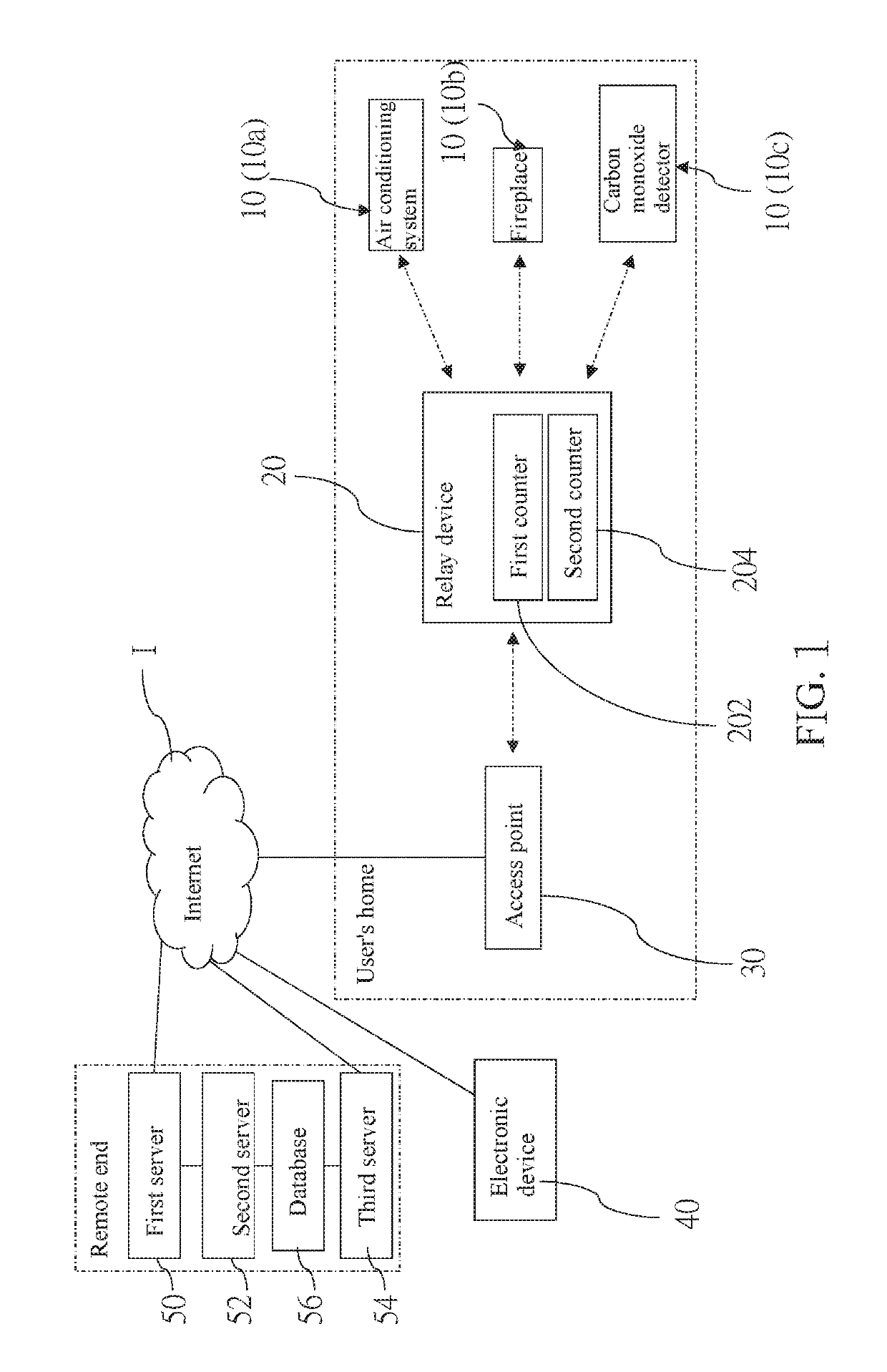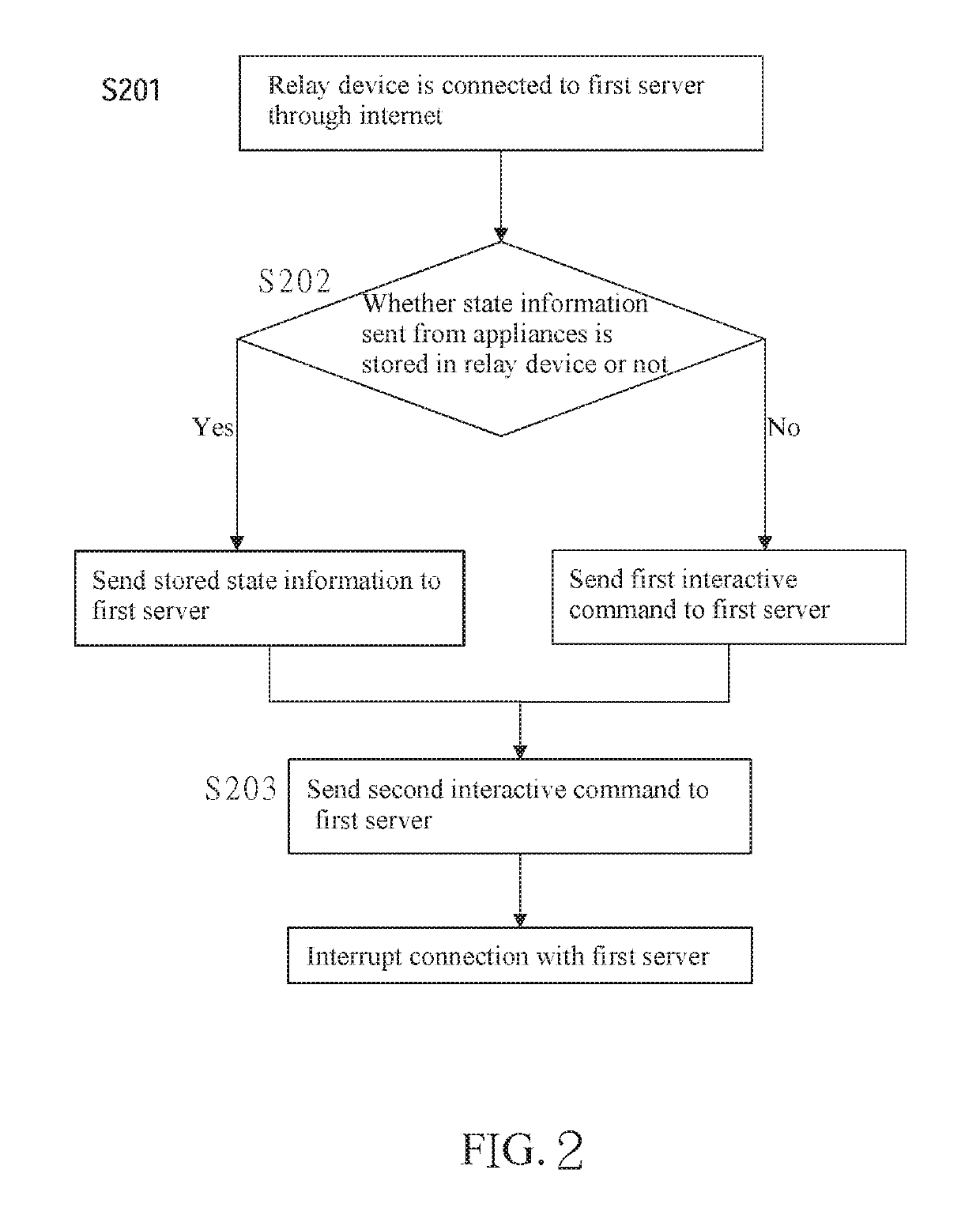Method for transmitting data in wireless system
a wireless system and wireless technology, applied in the field of wireless systems, can solve the problems of confusion of users, and the first server cannot determine whether the relay device sends state information or no
- Summary
- Abstract
- Description
- Claims
- Application Information
AI Technical Summary
Benefits of technology
Problems solved by technology
Method used
Image
Examples
first embodiment
[0017]A wireless system of the present invention is illustrated in FIG. 1, including at least one appliance 10, a relay device 20, an access point 30, an electronic device 40, a first server 50, a second server 52, and a third server 54.
[0018]In the current embodiment, the wireless system includes a plurality of appliances 10 which are located at a user's home, wherein the appliances 10 include two controllable appliances and one detection appliance. In the current embodiment, the controllable appliances are an air conditioning system 10a and a fireplace 10b as an example, and the detection appliance is a carbon monoxide detector 10c as an example. Each of the appliances 10 is wirelessly connected to the relay device 20 via a radio frequency signal (i.e., RF signal). However, the RF signal is not a limitation of the present invention. Other wireless signals such as Wi-Fi, Zigbee, Bluetooth, infrared, etc, also could be utilized. The controllable appliances are configured to receive ...
fifth embodiment
[0052]In addition, the method of the fifth embodiment further includes step S504 (as shown in FIG. 5B) after the connection between the first server 50 and the relay device 20 being interrupted in step S503. In step S504, the relay device 20 determines whether the value of the second counter 204 has reached a second final value.
[0053]If so, the relay device 20 interrupts the connection with the access point 30, and returning to step S500. In the current embodiment, once the connection between the access point 30 and the relay device 20 is interrupted, the relay device 20 restarts first, and then returning to step S500.
[0054]Otherwise, returning to step S501.
[0055]In the current embodiment, after the relay device 20 being connected to the access point 30 for a period of time, the relay device 20 could also be connected to the access point 30 again. Whereby, the connection between the relay device 20 and the access point 30 could be more stable.
[0056]A method for transmitting data in ...
fourth embodiment
[0062]In the current embodiment, when the relay device 20 is connected to the access point 30 after a time, the relay device 20 interrupts the connection between the access point 30 and the relay device 20. After the relay device 20 interrupting the connection with the access point 30, the relay device 20 restarts first, and is connected to the access point 30 then. In this way, the connection between the relay device 20 and the access point 30 could be more stable, whereby to avoid data loss, just like the
[0063]A method for transmitting data in a wireless system of a seventh embodiment is illustrated in FIG. 7A and FIG. 7B, wherein the method has almost the same steps as said method of the sixth embodiment.
[0064]The difference between the method of the seventh embodiment and that of the sixth embodiment is that, the method of the seventh embodiment includes step S700 before step S701, step S700 includes that the relay device 20 is connected to the access point 30.
PUM
 Login to View More
Login to View More Abstract
Description
Claims
Application Information
 Login to View More
Login to View More - R&D
- Intellectual Property
- Life Sciences
- Materials
- Tech Scout
- Unparalleled Data Quality
- Higher Quality Content
- 60% Fewer Hallucinations
Browse by: Latest US Patents, China's latest patents, Technical Efficacy Thesaurus, Application Domain, Technology Topic, Popular Technical Reports.
© 2025 PatSnap. All rights reserved.Legal|Privacy policy|Modern Slavery Act Transparency Statement|Sitemap|About US| Contact US: help@patsnap.com



